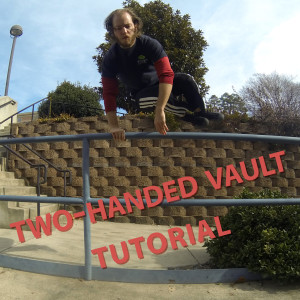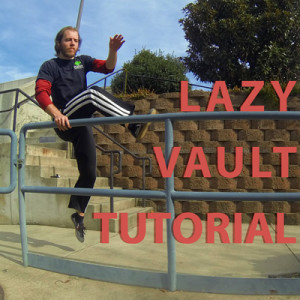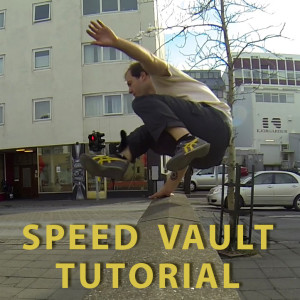Blog Entries
Squee!
Ahem...I've been on the fence about trying Ghost out for at least a month. Then I ran across an excellent tutorial on Tutsplus on how to build a Ghost theme from scratch. Highly recommended to learn the whole process.
I already had node.js installed to learn how to use Stylus as my CSS pre-processor so I spun up a local instance of Ghost and got to work.
I've been spending the past couple of weeks ripping apart the Inspyr theme for Wordpress and running into many little roadblocks when customizing the PHP, frustrating.
My experience so far with Ghost and Handlebars to handle templating has been near sublime in comparison. Setting up new page templates and understanding how partials work was so much quicker than wrapping my head around how hooks work in practice.
LESS to Stylus
The tutorial series linked above was excellent, with only one downside: the entire CSS workflow was built on using LESS...but I was going to use Stylus for it's python-esque elegance, especially after discovering the awesomeness of Jeet for managing a grid system.
Translating LESS syntax, especially around the math, ended up being an excellent way to learn the correct Stylus syntax, so a win-win there, even with a bit more time spent.
But finishing a single tutorial, however long, isn't a sign of actually learning how to theme Ghost. Next step? Theme this blog.
Oh, and then theme another existing blog which I'll be porting onto Ghost on a Digital Ocean droplet, because I hear that service is awesome.
Other challenges to try out:
- Mirror this Ghost development workflow to a Windows environment.
- Learn more about node.js, ember.js, and Javascript in general in order to extend Ghost's functionality, or at least lend a helping hand.
- Might be a ways down the road, but now that I've migrated this site onto Ghost properly I'll be trying my hand at a more specific theme. I like this one, but nothing like building your own sometimes.
For most of my life, I have been shy and reserved. In any social situation I generally stayed quiet and listened to others rather than becoming involved, preferring to stay on the periphery. I felt more comfortable being the outsider.
Although that's how I acted most often (and I still do when I'm way beyond my comfort zone) it does not reflect my true nature: how I act when no one is watching. That true element of me hides away at moments when I lack confidence in myself or am paralyzed by a fear of judgment. I am always worried that by speaking or drawing attention to myself I will label myself permanently as the weird one and remain forever an outsider and outcast.
Over the past eight years or so, however, I have experienced a slow evolution in myself. I don't feel like I have to stand back and observe life anymore; I can let my authentic self - talkative, silly, serious or whatever facet of me wants to be shown - act without fear of judgment. This ability to express my true personality more often came from a gradual improvement in self-confidence. My confidence has always been strongly tied to whether I judged myself as being strong and capable. In my shallow view of masculinity and self-worth, that was the key, if not the only, measure. This was the reason my self-confidence was so nonexistent in my younger days: for all my youth I believed myself to be weak. I was certain of it. Being seen as weak is one of my greatest worries, perhaps only second to not being taken seriously. So my story of self-confidence is also the story of learning how to feel comfortable and capable at my present level.
I remember dreading that Presidential Fitness test in Middle School - the thought of having my abilities measured and compared while everyone was watching was massively uncomfortable. When the moment arose during the pull-up test that year-I knew I couldn't do a single one; I tried on my own-I was so afraid of failing in front of the rest of the boys that when my turn came I was in a full-on fight-or-flight adrenal mode. I couldn't run away, so luckily for me, the magic superhuman strength-bestowing powers of adrenaline let me eke out two pull-ups after which I hung on, desperately trying for a third before the teacher finally asked me to let go.
I was still super shy and locked away any real self-esteem up until my senior year in high school, because by then I had been practicing martial arts for some months and was starting to feel like I was at least passingly competent. The only reason I even got that far was thanks to a welcoming community where it felt safe to learn and move. Training also got me out of my shell, ever so slightly, as I needed to interact with my training partners - one of the beautiful things about martial arts: community is essential to the practice - and over time that allowed me to open up more, on a regular basis; that kind of thing had only happened when I was talking about something I was passionate before. As the years wound on I grew far more talkative than I used to be, but I was still definitely shy, and the bulk of the confidence gained in the dojo stayed in the dojo. I still didn't believe I was "good enough" yet.
A couple years later I discovered parkour and, by the nature of the art, had to practice outside. Outside of the dojo I wasn't willing to let others see me practicing, learning, struggling, and failing. For a long time I trained parkour with no one around, and if I noticed someone wandering by I would stop and do something "normal;" I didn't want to look weird and especially didn't want to answer questions about what I was doing. Over time I got not only more skillful at the movements required but also noticeably physically stronger than I had been when practicing martial arts alone. After almost a year I found a little community to train with where I didn't feel awkward or judged. Through all of this I noticed that my overall energy, confidence, and ability to take initiative went through the roof. While those feelings come and go, the same trend of improving self-confidence has continued the longer I train and the more I keep gradually pushing the boundary of my comfort zone further out. The same process is underway through new channels I would have never touched before: dance; and now a little experiment with acting and stunts for a local community film project, Film in a Year.
But none of these would have ever been possible without the preceding steps on the path. With dance in particular, I've found the need to start practicing completely alone at first, then transitioning into dancing with a small welcoming community, then dancing "in public" with no audience (that is to say outdoors, in a public space, but without anyone around), then (and I'm still working on it) towards dancing for an active audience. Of course, unless you're into performance or teaching, you can skip that last daunting step.
The important point is that self-doubt will always be there, but by continually expanding your comfort zone outwards those doubts will shrink and interfere far less with your ability to take action. Acquiring physical skills is a powerful tool for building self-confidence and there is a clear process for pushing the edge of your comfort zone further, without pushing so far that you risk paralysis. Your confidence will build as your strength and skills improve, allowing you to do so many things you thought impossible before everywhere in your life; and that confidence will come not just from appearing stronger but being stronger, in body and in spirit.

"When no one is looking and you're not trying, what shows on your face?" - Seth Godin
_The title and post are inspired by a blog post of the same title by Seth Godin, Resting Smiley Face.
My answer?
Intensity.
More often than not I'm lost in my own thoughts or focused on the task at hand, and I display the face to match, one with focused intensity. When I was growing up my mother would frequently comment about my tendency to be intense, and with the benefits of hindsight I see it clearly. It's great, and necessary, to be focused when you need to, when you're performing at the edge of your abilities or tackling something that scares you. When that happens a face like the one below ain't so bad.
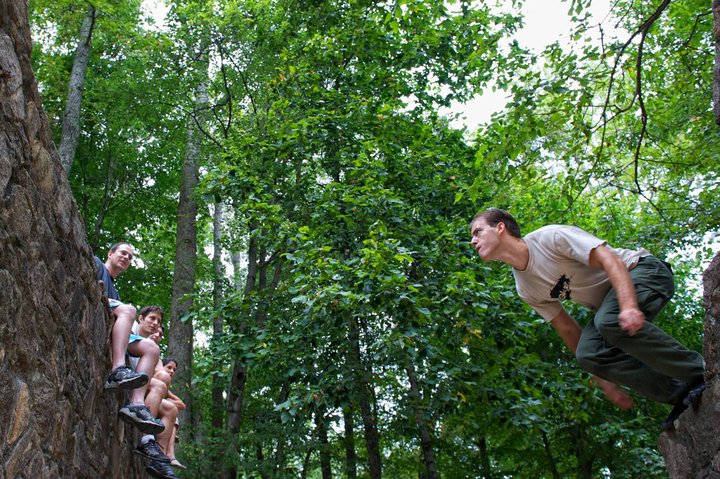
But it's not so great as a default. At minimum that face broadcasts "don't distract me right now" and quickly creates distance. At worst it may have lead, on many occasions, to people outright avoiding interacting at all. Not good.
Fortunately it's fixable.
This project, to reset my 'default face' has been an intermittent self-experiment since last November. The experiment began when I saw myself in a full-length mirror on the final day of my farm stay in Switzerland. Between the sadness of departure and other emotions I had been wrestling with I didn't look terribly inviting or easy to talk to. Maybe understandable given the circumstances, but still, it bothered me. I had already finished packing in preparation for my trek back to town, and I had time to kill waiting for my host to return so I could say farewell and thank him before venturing onward.
I took to playing around with expressions in the mirror and quickly noted how much better I looked with even a subtle smile tugging gently at the corners of my lips. I instantly appeared friendlier than moments before. Strangely enough just practicing holding the smile for a few minutes left me feeling happier as well (an effect that has been studied).
For the next month I practiced this regularly and felt, on average, better than usual, especially considering the constant flux of moods that travel creates. But like many habits, I eventually forgot to maintain it, and much of the gains from that month were lost. I believe part of the reason for losing the habit was I lacked a means for feedback. I couldn't see whether or not I was holding the expression, and had trouble feeling the subtle difference between the default and resting smiley modes.
Months later, while volunteering on a farm in Iceland, I began practicing again, this time determined to learn how to feel the difference in the expressions; the subtle adjustments of muscles around the mouth and around the eyes. Fortunately I had some days devoted to driving a tractor, tilling and preparing fields, which gave plenty of time for practice. I could set the small smile, refocus on the task of driving, then periodically check in the rear mirror to confirm I still held the smile. If I screwed up I could quickly re-adjust and repeat the process. After a day or two of practice I could consciously feel the difference between the two faces without a mirror. Now I could do a quick self-check anywhere to feel if I was reverting to the old default, and switch to the resting smiley face instead.
During this experiment I discovered a virtuous cycle. With the resting smiley as the default I felt a little happier, which lead me to put forth my silly and playful side more often, which then lead to feeling even better. My interactions are filled with more playful energy and genuine interest when I'm in this virtuous cycle.
Now whenever I'm feeling too serious or somber I can check for the resting smiley, and see a small mood boost from it. If that isn't enough, there's always the nuclear option: do something entirely silly and without purpose. My preferred methods are bobbing back and forth, dancing in place, using over-the-top facial expressions, and if it's real bad the gopher dance.
The playful energy you get can be channeled into your interactions and conversations, making them at minimum more fun, and hopefully more meaningful and memorable. The world has more than its share of somber pessimists, we could use more people who are thrumming with life and an endless curiousity.
The resting smiley face won't get you there on its own, but it's a great place to start.
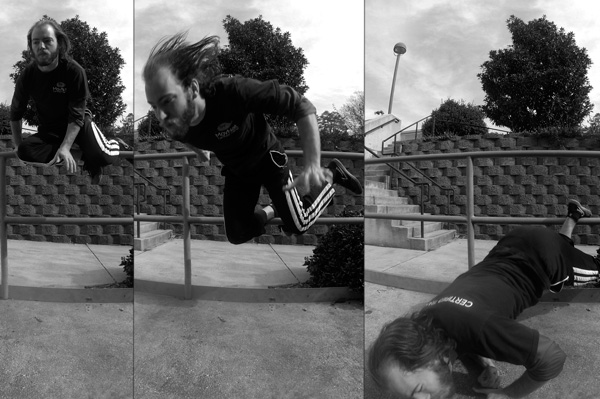
Look bad? Posting the failure here hurts more than the fall itself. That's despite it being the worst fall I've had in recent memory.
Sometimes it's the middle ground that's the most dangerous of them all. If the drop after the vault was bigger then I'd have more time to fix my in-air position (it's happened before and I always landed on my feet). If it were smaller there would be minimal impact.
How did it happen? As always the worst of them always happen when I'm not 100% present in the situation and I'm not giving the obstacle the respect it's due. I had an hour between classes and was gathering photos to update and expand the e-book. To do that I was taking burst photos, 30 in 3 seconds, which gave me a small time window from pushing the button to the executing the technique. On top of rushing I was already tired and had a headache (gotta love caffeine withdrawal) when I hit record.
Amusingly enough I jumped and gave myself more than enough power to sail straight over, but I wasn't focused and undershot my foot placement on top of the rail, hooking it behind me after I had already cleared.
Not good. I had milliseconds from recognizing my mistake to hitting the ground and I couldn't be in a worse position; no forward momentum or space to roll forwards, legs taken out, and diving headfirst (with no rotation). Knowing all of that didn't matter anyway. I hit the ground before I had time to think.
In those moments of falling all you have to keep you safe is your body's subconscious training. After the impact it took me a second to process that I had fallen. Right away, as is habit, I performed a quick damage assessment, and found that I was okay. The breakfall wasn't perfect, but I came away with just some scrapes on my right hand, minor bruising on the left palm, and the tiniest scratch where my cheek grazed the ground. The perfectionist* in me thinks, "coulda been better," but it avoided face smashing and lasting injury. That's all that matters.
*The fall itself is interesting to analyze. It was a modified forward breakfall. My left hand made contact a little too early but still relaxed into the fall, avoiding serious damage. The right was closer to the correct technique (aside from the palm being up), spreading the impact from hand to elbow. Bonus points to my body for leveraging the right shoulder to further protect my face. Pulling off a forward roll into a weak forward breakfall (little space to finish the roll) would have been potentially better, but I'm being picky.
I walked away from that fall nearly unscathed and rushed off to teach class. That wouldn't have happened without specific training. Correct (safe) reactions during a fall only show up when the techniques are engrained into your subconscious mind and that will only happen after loads of practice. Before that day I had fallen plenty of times, many times intentionally and sometimes not so much, which acclimated my body to the experience of falling.
We all fall occasionally, whether during day to day activities or during training. You can't avoid it, only prepare for it. Find some soft ground to practice (grass, carpet, mats) and practice your rolls and breakfalling skills. Parkour Ukemi has some excellent resources on rolling and specific falling drills which I'll link below. Right now I don't have my own online resources on the subject, but that's risen nearer the top of the list now. I'll update this post as they're added.
Choose to land gracefully.
Resources:
I've got my hands on an awesome plugin, UberGrid (aff link) for making resizable grids and for a simple way to handle the massive number of videos I have on Play Everywhere. And thus I realized I needed some thumbnail style images for all the videos, because the auto-generated ones from Youtube were crap.
So time to experiment with minimal typography and use of color for these. The thumbnails I see on youtube sometimes with the super heavy thick strokes or other effects feel a bit tacky to me, so I'm trying something a bit simpler. For a bit of contrast at distance I've added a sign-painter style drop-shadow, but that may not stay in the final versions. Otherwise setting type in styles that fit the name and direction of travel.
The way these images line up without any adjustments to code is also a perfect example of why grid based plug-ins (or custom CSS like purecss) are great for creating beautiful, symmetrical, layouts.
Whew, who knew how much effort went into just laying out the text for a book. Just wrapped up the project for a Skillshare class on styling novel interiors.
Have a look!
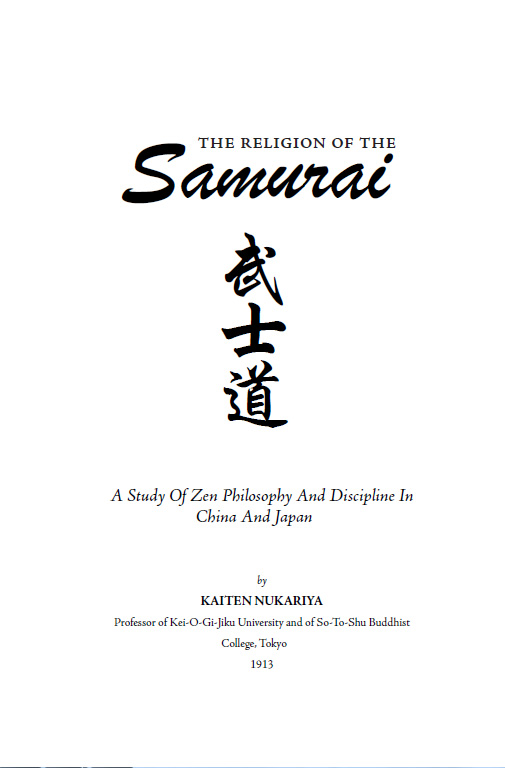
The main title page for my Religion of the Samurai project.
Playing with pairing fonts, basic geometric designs, and the blend tool in Illustrator.
After finishing a book about Bauhaus I wanted to try to emulate some of the formative practices they used in their courses. Part of the preliminary courses at the school were studies in using color and basic shapes for ideas. On top of that I just discovered that the blend tool in illustrator could quickly create hundreds of objects, so with that in mind this experiment happened. Also decided to see how I could use the personality of different fonts and pair them together, without relying on color to convey the emotion of the text.
Humanist style serifs, hand-lettered.
One of the first things I went to the moment I got some good brush markers was lettering. I'm not sure why it attracts me at this point, besides the attraction to typography in general. Grids are amazingly helpful, but right now even with them I'm sucking at creating elegant curves in some letters. C, I'm looking at you.
I say "over, under, and through" a lot when talking about obstacles. Recently I was inspired to take that same idea and turn it into a simple game.
The rules: You have three moves to connect. One must be over an obstacle, another must be through it, and the third under it. That's it for the basics.
You can do a single set of three then take a break, or try to take it further and chain multiple sets together. This game works for single obstacles and potentially even better if you have many obstacles available. Railings are ideal, but with some creativity anything can work.
As per the video you can apply additional rules to increase the challenge. Make the ground lava, limit where you can step, or do crazy things like try to move only backwards or sideways. Feel free to experiment and try different things.
Go forth and play! Share what you came up with in the comments or via email.

